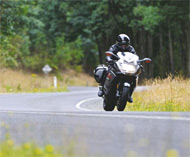
Lucky 13?
Brendan Nelson almost sounds as if he’s sorry he ponied up for his Hayabusa
Photos: Keith Muir, BMW Factory, Brendan Nelson
Europe’s largest motorcycle manufacturer was using this year’s Superbikes at the Island not only to introduce its S1000RR race bike (Go Troy), but also to launch the much-anticipated K 1300 series. We had to be there.
I have never owned a BMW. I had not previously ridden one. The closest I came to one was a police officer asking why my fog lights were on in the absence of fog. Despite that I retain no prejudice one way or the other. To me they always look good, great technology, well engineered, pricey, tragic devotees, go forever and – ahem, perhaps a little boring except for the K 1200 S.
But I wasn’t thinking any of this when glancing at the speedo of the naked K 1300 R to note that I was doing 230km/h down Gardner Straight with more to spare. I just thought, “This thing is bloody brilliant.” This was even more so as I’d just passed a bloke on a Ducati 1098.
Three for one
There are three bikes in the K 1300 series. Although the “S” and “R” are similar, there are real differences in looks and performance. Some are significant, others subtle. The Grand Turismo (GT) is different again.
Given that stocks of the much loved K 1200 series are all but gone, some might try to tell you the K 1300 is a simple upgrade. Devotees of the marque say it’s not. On paper it’s definitely not.
As the economy slows quicker than a Rocket III rider who’s seen a radar gun, BMW is keen for picky customers in an ultra-competitive market (“love, we need new carpet more than a new bike”) to see this as a really new bike retaining the strengths and lines of the 1200. I reckon they’ve pulled it off.
One attraction is more power. The guys at BMW kept emphasising extra “usable power”. Having recently acquired a Suzuki GSX1300 Hayabusa, I think I know what they’re getting at. To get there, the engine has had an upgrade with better air and engine management, combustion chamber and exhaust system. But the real improvements are in technology.
Read on.
K 1300 S
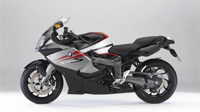
The K 1300 S has kept some of the lines of the K 1200 S, but it has been significantly upgraded with improved aerodynamics. From running it around at Phillip Island at more than 200km/h to winding along speed limited roads in the Victorian countryside, it was a magnificent machine. It is certainly powerful, putting out 139kW at 9250rpm, but it’s nimble as well.
Its instrumentation is simple, easy to read and with a variety of mind-boggling warning mechanisms for everything from underinflated tyres to disengaged ABS. The “S” handles superbly on track, road and even comfortably over the short gravel distances where both ABS and electronic traction control easily kick in if the bike is asked to do more than is safe.
The seating position is perfect, especially for someone like me of average height and build. The bike can be leaned well over with clean lines and great clearance. The Contis that came with the demonstration model showed evidence of wear and tear after 25 or so rounds at Phillip Island and a road day with chew marks extending to the very edges. That was more a reflection of what was asked of them than the tyres themselves, I’d suggest.
The short faring is well designed and placed, providing just the right amount of screening without detracting from performance. One of the bikes had BMW panniers fitted and I didn’t even know they were there.
The switch gear is simple and a vast improvement, so BM tragics tell me. Certainly the cockpit is simple in design but comprehensive in information.
What I really liked – and I mean really, was the “quick shift” gear changing on the “S” and the “R”. This is an outstanding innovation. From first to second there is not much difference – still the clunk – but moving up through the gears while pulling away with the throttle open and no clutch is just pure magic.
I know some people go on about brakes, but these are brilliant. This is one of those bikes with a braking performance that even exceeds its power output.
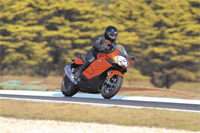
I gave the ABS a run on gravel, no problems there. The brakes both front and rear disengaged at the first loss of traction. Then, out on the road I gave it the full white knuckle pull on the front brake. It pulls up in a straight line with the ABS kicking in instantly, confidently and reliably front and back.
A further innovation is the optional ESA II (Electronic Suspension Adjustment). In plain language, you can automatically set suspension height, spring rate and damper settings. I know the experts go on about this sort of thing, but even I could notice the bike firmer or softer in its ride.
Our demo “S” also came with another BMW goodie – Automatic Stability Control (ASC). The engine basically disengages to prevent the rear wheel spinning. I gave it a go on gravel and couldn’t fall off. In other words it works! As we were riding on damp country roads for a bit of the day, conditions were ideal for the ABS/ASC combo. As I prefer to leave little to chance and even less to technology, I didn’t call on either, but others did!
The pillion position is comfortable, well above that of the rider to give easy vision. Anti-vibration handle bars are well positioned. Even snuggling down onto the tank on the race track was comfortable. Equally, out on the open road my 50-year-old wrists and arms felt not the slightest discomfort. Yes, it’ll easily tolerate long-distance touring.
This will be an extremely appealing bike for someone looking for a safe, brilliantly designed performance bike that can tour, has state of the art technology and safety features that will hold good resale value backed by a reputable company.
In the end, for many buyers it will be about price. For others with discerning wives it will be about colour. Why only metallic orange, grey and tricolour? I thought the all-black K 1200 S was really special. But hey, that’s progress and what would I know? I’m colour blind.
K 1300 R
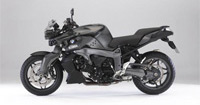
Lighter than the “S”, the “R” is similar in style but actually quite different. That’s probably why the guys at BMW promote the “R” as “controlled but never tame”.
It has that muscular “Don’t mess with me” air about it. Like its “S” stable mate, it has more power and torque than its 1200 predecessor.
Unlike the “S”, the radiator is exposed but snug up under the headlights. The small screen has a prominent speedometer neatly tucked behind it and just up to its right, the tacho with its red line at 11,000rpm. As with the “S”, the levers and switches are simple and there is no need for an engineering or science degree to work out the variety of functions the electronics and instrumentation system can deliver.
The impression is of a high-mounted tank, tiered rider/pillion seat (so your partner can actually see where you’re going), dual headlights and a forward tank and engine moulding giving the impression of a mini faring.
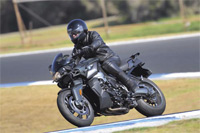
The torque curve is beefy and, as with the “S”, it seems to take on a second surge of get up and go on the track at about 8000rpm.
The quick shift system again is exhilarating, particularly from second up through the gears when powering away. Whether it was around the Phillip Island track or out on Victorian country roads, the “R” corners brilliantly, grips the road and with the electronic traction control system, is forgiving for the odd loss of traction – the engine briefly cutting power as the bike regains its grip. I confess to one brief lapse on the “R”.
Personally, although the “R” is lighter and cheaper than the “S”, BMW buyers in the range should try and squeeze a little bit more money out of the Minister for Finance and War to go for the “S”. Both bikes are undoubtedly versatile, could lend themselves to both touring and sports use, but for my money the “S” is brilliant.
K 1300 GT
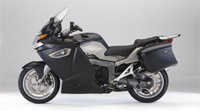
Going from the K 1200 S and R to the K 1300 GT is like going from a sports car to the family wagon! This is basically the BMW “mother ship”. Not quite the proportions of a Goldwing, the K 1300 GT is nonetheless physically imposing.
From the front guard through to the rear end of the purpose-built panniers, if the “R” is muscular, the “GT” is handsome.
Although I thought the centre of gravity could be a bit lower, the bike is surprisingly easy to get off the side stand and manoeuvre on uneven surfaces and gravel. Sitting in a typical touring position, the bars are well placed with simple, uncluttered switches that include screen height adjustment, cruise control and of course the info and ASC/ESA switches of the 1300 range.
A myriad of technical data is available from the centrally placed electronic screen that sits between the speedo and tacho, both of which are quite large. There is some glare at times, especially with the windscreen, which can make it a little difficult to check your speed quickly.
Everything you want to know is available from the electronic onboard computer – tyre pressure, ambient temperature, range, average speed, fuel consumption. All can be instantly gleaned from scrolling through the data with the info switch.
Pillion seating as always with the BMW touring range is comfortable, with the added bonus of a heated rider and pillion seat with separate switching. A luggage rack sits over the tail lights and blinkers.
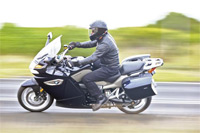
The K 1300 GT is extremely smooth with plenty of power for moving through the sweeping bends of the often mountainous country through which we travelled. The bike powers through anything, steady as a rock on the damp roads.
I hit the discomfort button big time through a 40km/h bend at 60km/h. Right on the road in my line was a cow pad. I needn’t have worried. The bike responded well to, err, avoidance measures.
The ABS is standard on the “GT”, with ESA a welcome addition on the test bike. I really appreciated the different settings on the “GT”, more so than on the “S” and “R”. For electronic traction control you need to go to the SE – given its obvious benefits, probably a worthwhile investment. At this end of the market, a bit more money can make a big difference.
Returning to Melbourne on the “GT” was a bit of a challenge. Turbo-charged winds and heat didn’t make it the most pleasant of days. In these conditions, the bike moved around more than I expected. The high winds further accentuated the annoying wind that seemed to blow over the top of the windscreen irrespective of its height.
The other surprise for me as a non-BMW rider was the lack of comfort of the seat on the GT. After a little over an hour I was starting to feel it. Surprising, I thought, for the flagship of a great touring marque. The seat, handlebars and foot pegs are all adjustable so I might just have had the wrong settings on the day. Then again, perhaps it was me and the unusual conditions. If you’re thinking of buying one, give it a really good test run.
And here’s a final tip: even if you’re set on something else, take the “S” for a blast before handing over your hard earned for something else. You might be surprised. I was.
Most Searched Terms: BMW Motorbikes in Australia, BMW K1300 Series, Motorbike Reviews, Best New Motorbikes Available in Australia, Best New Motorbikes For Sale in Australia, Motorcycles for Bike Touring, Road Bike Trips Victoria, Queensland, South Australia, New South Wales, Western Australia, Tasmania, Sydney, Melbourne, Brisbane, Perth, Adelaide, Canberra, Motorbikes in Australia, Motorcycles in Sydney, Bike Riding around Melbourne, Brisbane Motorbike Clubs, Perth Motorcyclists, Adelaide Hills, Canberra Motorbikes, Tasmania’s Best Motorbike Tours, Motorbike Trips around Australia, Touring Australia on a Motorbike, Queensland Bike Tours, Victoria’s Best Motorbike Trips, Motorbikes in New South Wales, Bike-riders in Western Australia, South Australia’s Best Motorcycle Journeys, Road Rider Magazine.
